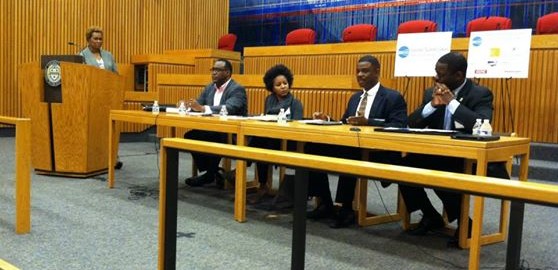Conjunction Junction What’s Your Function? The “And” Equation
June 11-13 marked the second convening for the Global Great Lakes Network in Pittsburgh. Building on the Detroit convening’s success in 2013, this year’s event drew over 200 participants from some 20 different metro regions across the Rust Belt. By all accounts the highlight of the convening was the panel discussion on African-American and immigrant relations.
Jonathan Holifield, the Vice-President for Inclusive Competitiveness at Nortech, a Cleveland area tech economy accelerator, set the tone of the panel early by asking “Conjunction Junction what’s your function?” and noting that the African-American and immigrant agenda necessitated an “And” conjunction. Defining economic development as “capital, talent, and deal flow,” Holifield noted that an immigrant attraction strategy “absent incumbent talent inclusion, is leaving some of each of these on the table.”
While all the panelists were generally optimistic about the possibilities for collaboration and exchange between African-American and immigrant populations, they also cautioned against the follies of the past. Dr. Christina Greer, a professor of political science at Fordham University who has done extensive social science research on African-American, African, and Caribbean perspectives in a new bookBlack Ethnics: Race, Immigration, and the Pursuit of the American Dream, reminded the audience that a rising tide has not always proven to lift all boats. The message was clear, local immigrant economic development initiatives like Global Detroit must take proactive steps to create an environment that encourages new economic development and job growth while ensuring that economic gains reach all communities.
The panelists emphasized the need to forge relationships and mutually-beneficial partnerships between new immigrant communities and African-Americans. “It is not just about this [immigrant] group is going to create jobs for you, no, here are opportunities to form partnerships by leveraging those social structures that exist in the black community,” said panelist Todd Q. Adams, Chief Officer for Sustainability and Innovation at Visibility Marketing. Immigrant communities can learn from African-American communities and vice-versa. Such a two-way exchange can de-mystify cultural differences and help to form lasting collaborations among the communities which lead to optimal economic outcomes for all.
After discussing the challenges and opportunities for alliances between African-American and immigrant communities, the panel turned to the fundamental question of how to begin the conversation. Detroit City Councilman Andre Spivey began the conversation by asking, “I am an optimist, but I know we don’t live in Utopia. Where do we begin the conversation that African-Americans and our immigrant friends can come together and make collaborations and coalitions? And who leads the charge to begin that conversation?” He went on to describe how the community outreach around immigration has primarily taken place in “safe places”, like university symposia and committee planning hearings. By isolating the conversation to those spaces, African-American voices are frequently excluded, and we miss the opportunity to start a dialogue. Instead of relying on those places to have dialogue about immigration issues, Spivey expressed the need to get out into the neighborhoods and enlist community leaders as partners. Todd Q. Adams echoed Spivey’s comments by calling for a new community engagement model which takes the conversation about immigration into the neighborhoods and focusses on youth and community leaders as the conduit by which to begin conversations about immigration in the African-American community.
Economic development strategies that benefit both immigrant and African-American communities equally often stop as soon as there is a perception of competition between the groups. Through neighborhood-level advocacy, we can involve African-American community leaders in the planning process. Only then we can overcome the initial resistance to immigration as an economic development tool, and begin to have an inclusive “and-based” conversation about a strategy which can benefit everyone.
If we are committed to cultural competency when working with immigrant communities, then it is no different when working with any community. All communities have unique cultures, histories, interests, and strengths. To succeed, we must partner with local leaders and engage them in conversations about their communities’ interests and concerns. By collaborating with these leaders in the planning process, they can become our partners and teachers in forming broad based strategies to revitalize our economies. Councilman Spivey voiced the sentiments of many when he said that Detroit will be “one of history’s greatest comeback stories.” By actively including all of our distinct communities in the planning process, we can make that comeback story a reality.
The Global Great Lakes Network deserves great credit for tackling this issue heads on and making this discussion one of three of its plenary sessions that all participants heard. The panel was challenging to both the audience and the participants and it likely raised more questions than it answered, but it broke the ice on a critical element that immigration economic development initiatives in the Midwest need to tackle. We hope this is only the beginning of the dialogue.




